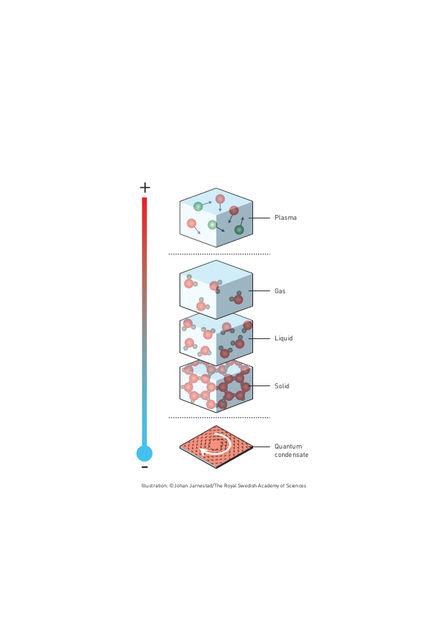David Thouless, Duncan Haldan and Michael Kosterlitz received Nobel Prize for Physics
Nobel Prize for Physics 2016
The three british originated researchers David Thouless, Duncan Haldan and Michael Kosterlitz receive the Nobel prize for physics for their research of unusual states and phases of matter.

Phase transition
Illustration: ©Johan Jarnestad/The Royal Swedish Academy of Sciences

Phases of matter
llustration: ©Johan Jarnestad/The Royal Swedish Academy of Sciences

Topology
Illustration: ©Johan Jarnestad/The Royal Swedish Academy of Sciences



David Thouless is awarded with one half, the Duncan Haldan and Michael Kosterlitz with the second half of the Nobel Prize
They revealed the secrets of exotic matter
This year’s Laureates opened the door on an unknown world where matter can assume strange states. They have used advanced mathematical methods to study unusual phases, or states, of matter, such as superconductors, superfluids or thin magnetic films. Thanks to their pioneering work, the hunt is now on for new and exotic phases of matter. Many people are hopeful of future applications in both materials science and electronics.
The three Laureates’ use of topological concepts in physics was decisive for their discoveries. Topology is a branch of mathematics that describes properties that only change step-wise. Using topology as a tool, they were able to astound the experts. In the early 1970s, Michael Kosterlitz and David Thouless overturned the then current theory that superconductivity or suprafluidity could not occur in thin layers. They demonstrated that superconductivity could occur at low temperatures and also explained the mechanism, phase transition, that makes superconductivity disappear at higher temperatures.
In the 1980s, Thouless was able to explain a previous experiment with very thin electrically conducting layers in which conductance was precisely measured as integer steps. He showed that these integers were topological in their nature. At around the same time, Duncan Haldane discovered how topological concepts can be used to understand the properties of chains of small magnets found in some materials.
We now know of many topological phases, not only in thin layers and threads, but also in ordinary three-dimensional materials. Over the last decade, this area has boosted frontline research in condensed matter physics, not least because of the hope that topological materials could be used in new generations of electronics and superconductors, or in future quantum computers. Current research is revealing the secrets of matter in the exotic worlds discovered by this year’s Nobel Laureates.
The laureates
-
David J. Thouless, born 1934 in Bearsden, UK. Ph.D. 1958 from Cornell University. Emeritus Professor at the University of Washington.
F. Duncan M. Haldane, born 1951 in London, UK. Ph.D. 1978 from Cambridge University. Eugene Higgins Professor of Physics at Princeton University.
J. Michael Kosterlitz, born 1942 in Aberdeen, UK. Ph.D. 1969 from Oxford University. Harrison E. Farnsworth Professor of Physics at Brown University.
Most read news
Topics
Organizations
Other news from the department people

Get the analytics and lab tech industry in your inbox
By submitting this form you agree that LUMITOS AG will send you the newsletter(s) selected above by email. Your data will not be passed on to third parties. Your data will be stored and processed in accordance with our data protection regulations. LUMITOS may contact you by email for the purpose of advertising or market and opinion surveys. You can revoke your consent at any time without giving reasons to LUMITOS AG, Ernst-Augustin-Str. 2, 12489 Berlin, Germany or by e-mail at revoke@lumitos.com with effect for the future. In addition, each email contains a link to unsubscribe from the corresponding newsletter.




























































